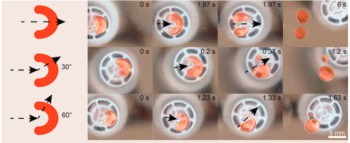
Droplets of both oil and water will move along specialized narrow channels by causing the channel walls to bend. That is the discovery of Dominic Vella and colleagues at the UK’s University of Oxford, who have dubbed this unusual motion “bendotaxis”. The phenomenon could be exploited in a range of applications from targeted drug delivery to labs-on-a-chip.
Controlling the flow of liquid droplets in narrow channels is playing an increasing role in technologies such as labs-on-a-chip and tiny devices that deliver drugs to targeted parts of the body. It can be a very complicated process because fluid motion in small channels is strongly affected by interactions with channel walls.
Currently, liquid droplets are propelled through narrow channels using driving forces created by things such as temperature gradients, electric fields or chemical gradients. As soon as these forces are removed, however, droplets will no longer move. This makes these methods unsuitable for applications where a driving force cannot be easily maintained, such as in a capsule placed inside the body for targeted drug delivery.
Clamped coverslips
Vella and colleagues have now created a channel in which no external driving force is needed to transport droplets. To do this, they formed a channel from two thin glass coverslips, coated in a material that attracts oil but repels water. The coverslips are clamped at one end and are held apart by a glass spacer just few hundred microns thick (see figure). This creates a channel with walls that are able to move together or apart.
Droplets of both oil or water were placed at the clamped end of the channel. To the team’s surprise, both types of droplet transported themselves towards the open end of the channel at speeds of several hundred microns per second. Vella and colleagues believe that the motion is a result of pressure gradients forming along the length of the droplets, as the droplets act to minimize their surface tension energy.

Counting wrinkles reveals pressure
The team says that different mechanisms are involved in the propulsion of oil and water. Oil droplets tend to spread-out on the coverslip surfaces to make as much contact as possible. This pulls the walls of the channel together, narrowing the end of the droplet facing the open end of the channel. Then, a pressure gradient forms within the droplet, pulling it towards the channel’s open end as it acted to minimize its surface tension.
In contrast, water droplets are repelled by the coverslip surfaces, pushing the channel walls apart. This makes the droplet wider towards the channel’s open end, creating a pulling force in the same direction as experienced by the oil droplet, again to minimize surface tension.
Vella’s team coined the term ‘bendotaxis’ to describe the motions they observed, since the droplets propel themselves – a behaviour called “taxis” – by bending their surroundings.
The research is described in Physical Review Letters.



